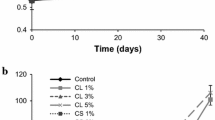Abstract
The odor detection thresholds of carvacrol (5-isopropyl-2-methyl-phenol), thymol (2-isopropyl-5-methyl-phenol) and p-cymene 2,3-diol (2,3-dihydroxy-4-isopropyl-1-methyl-benzene) in sunflower oil, determined by the three-alternative, forced-choice procedure, were 30.97, 124 and 794.33 mg kg−1, respectively. Sunflower oil containing 13, 70, or 335 mg kg−1 of carvacrol, thymol or p-cymene 2,3-diol, respectively, was judged to be similar (P < 0.01) in taste and odor to its antioxidant-free counterpart. The rate constant of sunflower oil oxidation, measured from the increase in peroxide value during storage at 25 °C, was 9.2 × 10−9 mol kg−1 s−1 while the rate constants were 9.3 × 10−9, 9.8 × 10−9, and 4.3 × 10−9 mol kg−1 s−1 in the presence of 13 mg kg−1 carvacrol, 70 mg kg−1 thymol, and 335 mg kg−1 p-cymene 2,3-diol, respectively. At a level of 335 mg kg−1, p-cymene 2,3-diol did not impart flavor taints and effected a 46.7% reduction in the rate of oxidation of sunflower oil. These findings indicate that the diphenolic p-cymene 2,3-diol could potentially replace synthetic antioxidants and is a valuable addition to the antioxidants used by the food industry in its quest to meet consumer demands for synthetic-additives-free and ‘natural’ foods.



Similar content being viewed by others
References
Choe E, Min DB (2006) Mechanisms and factors for edible oil oxidation. Compr Rev Food Sci Food Safety 5:169–186
Frankel EN (1998) Lipid oxidation. The Oily Press, Dundee, pp 115–160
Miková K (2001) The regulation of antioxidants in food. In: Pokorný J, Yanishlieva N, Gordon M (eds) Antioxidants in food. Woodhead Publishing, Cambridge, pp 267–284
Sasaki YF, Kawaguchi S, Kamaya A, Ohshita M, Kabasawa K, Iwama K, Taniguchi K, Tsuda S (2002) The comet assay with 8 mouse organs: results with 39 currently used food additives. Mutat Res-Genet Toxicol Environ Mutagenesis 519:103–119
Pszczola DE (2001) Antioxidants: from preserving food quality to quality of life. Food Technol 55:51–59
Dimitrios B (2006) Sources of natural phenolic antioxidants. Trends Food Sci Technol 17:505–512
Shahidi F, Naczk M (2004) Phenolics in food and nutraceuticals. CRC Press, Boca Raton, pp 443–481
Dapkevicius A, van Beek TA, Lelyveld GP, van Veldhuizen A, de Groot A, Linsen JPH, Venskutonis R (2002) Isolation and structural elucidation of radical scavengers from Thymus vulgaris leaves. J Nat Prod 65:892–896
Schwartz K, Ernst H Ternes W (1996) Evaluation of antioxidative constituents from thyme. J Sci Food Agric 70:217–223
Meilgaard M, Civille GV, Carr BT (1999) Sensory evaluation techniques, 3rd edn. CRC Press, Boca Raton
ASTM (2000) Standard practice for defining and calculating individual and group sensory thresholds from forced-choice data sets of intermediate size. In: Annual Book of ASTM Standards, ASTM Press, Pennsylvania, Method E 1432–91
Yanishlieva NV, Marinova EM, Gordon MH, Raneva VG (1999) Antioxidant activity and mechanism of action of thymol and carvacrol in two lipid systems. Food Chem 64:59–66
AOCS (1998) Peroxide value: acetic acid-chloroform method. In: Official methods and recommended practices of the American Oil Chemists Society, 5th edn. American Oil Chemists Society, Illinois, Method Cd, pp 8–53
Marinova EM, Yanishlieva NV (1992) Effect of temperature on the antioxidative action of inhibitors in lipid autoxidation. J Sci Food Agric 60:313–318
SPSS (2005) User’s guide: statistics, Version 14.0. SPSS Inc., Chicago
Origin (2000) User’s guide, Version 6.0. Microcal Software Inc., Massachusetts
Buttery RG, Ling LC (1997) 2-Ethyl-3,5-dimethylpyrazine and 2-ethyl-3,6-dimethylpyrazine: odor thresholds in water solution. Lebensm–Wiss u–Technol 30:109–110
Cometto-Muniz JE, Cain WS, Abraham MH, Kumarsingh R (1998) Trigeminal and olfactory chemosensory impact of selected terpenes. Pharmacol Biochem Behav 60:765–770
Heijnen CGM, Haenen GRMM, Oostveen RM, Stalpers EM, Bast A (2002) Protection of flavonoids against lipid peroxidation: the structure activity relationship revisited. Free Radic Res 36:575–581
Siquet C, Paiva-Martins F, Lima JLFC, Reis S, Borges F (2006) Antioxidant profile of dihydroxy- and trihydroxyphenolic acids—a structure-activity relationship study. Free Radic Res 40:433–442
Author information
Authors and Affiliations
Corresponding author
About this article
Cite this article
Bitar, A., Ghaddar, T., Malek, A. et al. Sensory Thresholds of Selected Phenolic Constituents from Thyme and their Antioxidant Potential in Sunflower Oil. J Am Oil Chem Soc 85, 641–646 (2008). https://doi.org/10.1007/s11746-008-1244-8
Received:
Revised:
Accepted:
Published:
Issue Date:
DOI: https://doi.org/10.1007/s11746-008-1244-8




